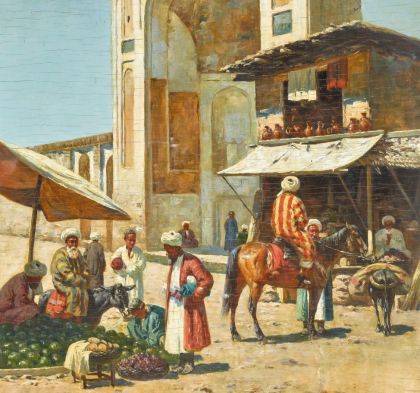Pirate Khanate of Astrakhan
The Pirate Khanate of Astrakhan is a semi-lawless region located in the Caspian Depression on the northwest corner of the Caspian Sea, centered upon the Volga Delta. The city of Astrakhan is within the delta, which provides it with a natural defense against foreign entities who might with to plunder or assert their authority over the city. The outer oblast is sparsely populated, primarily occupied by cossacks and other nomadic peoples.
The Khanate covers an area of 117.5 hexes and has a population of 45,702.
Geography
Behind the city of Astrakhan lie extensive salt marshes, so that travelling by water is greatly preferable to approaching the city on foot. The environment is largely unhealthy and bad epidemics have occurred. The city is 70 ft. below sea level, so that earthen dikes 14 ft. high are required to keep the city from flooding in the Spring.
History
The region was formerly occupied by the Khazars from the 7th to 10th centuries, and afterwards by the Golden Horde following the establishment of a Mongol Khanate in the 13th century. Tamerlane burnt the city to thre ground in 1395; the city took 65 years to return to its former size, whereupon the Astrakhan Khanate was declared. Ivan the Terrible tried to occupy the khanate in 1556, but his Moskvite force was driven out by the established Jagatai Empire, who then claimed Astrakhan as their province. The Jagatai were ousted in 1569 by the Ottomans, who besieged the city, defeating the Jagatai but retreating themselves in disorder a year later.
An agreement with the Ottoman Sultan in 1570 — that was soon extended to Russia — promised safe passage for Muslim and Christian Orthodox pilgrims and traders from Central Asia, opening the entire Volga River to commercial traffic. Today, Astrakhan is a multi-cultural city with a large orc and haruchai population, as well as humans, dworkin and Harnian gnomes. A significant Jewish population exists.
Culture
Pestilence and destructive fires often cause temporary declines in prosperity; as such, many of the structures are made of mud brick instead of wood, though the greater weight of these clay buildings causes them to sink. Goods moving between European Russia and central Asia on Caspian Sea boats are transferred at Astrakhan to and from smaller Volga boats. While the harbor is a busy one, excessive silting of the channel detracts from the value of the port and prevents entry of large vessels.
List of Settlements
| Name | Population | Year founded |
References |
|---|---|---|---|
| Astrakhan | 12,841 | 1002 | |
| Langan | 182 | 1002 |
